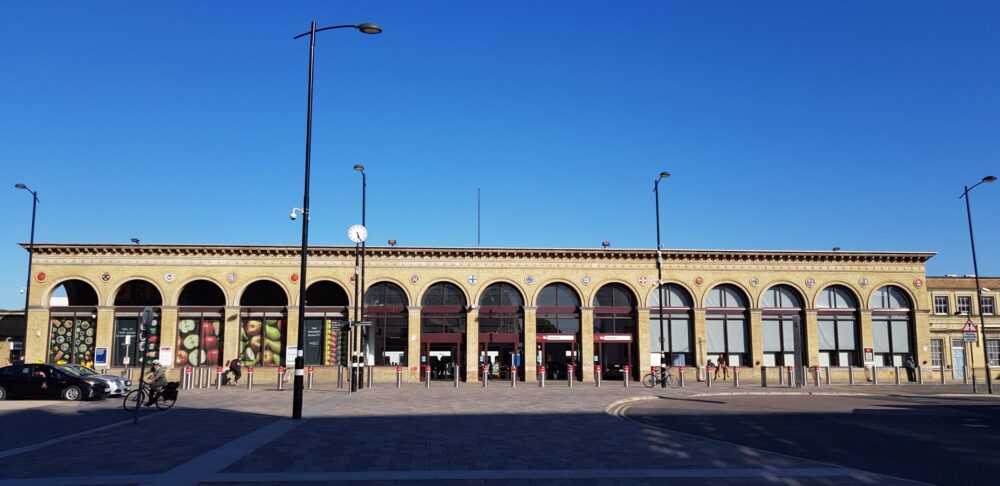Cambridge station is 175 years old
July 31, 2020

Cambridge railway station and the line from Cambridge to Bishop’s Stortford celebrate their 175th birthdays today (29 July).
The station’s first brick was laid on 10 April 1845. It – and the new line between Cambridge and Bishop’s Stortford – opened just three months later on 29 July that year, initially serving Bishopsgate station in London via Stratford and Bishops Stortford. The line between Cambridge and Norwich opened a day later.
Outside of London, Cambridge was the busiest station on Greater Anglia’s network before the coronavirus outbreak, seeing a 22 per cent increase in people using the station to almost 12 million per year. Its growing numbers led to the construction of an additional island platform to the east a few years ago.
In recent years the station has been restored to its former glory following refurbishment and redevelopment work carried out by Greater Anglia, with funding from the Railway Heritage Trust, leading to it receiving an Award for Urban Heritage in 2018 and two Station of the Year Awards.
Thanks to the work – including painstakingly restoring 32 ornate college roundels on the station’s façade, cleaning and repairing damaged brickwork and tidying up unsightly cabling and surface pipes – the station looks as good today as it did 175 years ago.
Work to carefully restore the mouldings, removal of the redundant cabling and repairing of damaged brickwork on the Grade II listed station cost £250K and took a year to complete, involving detailed research to ensure the correct colours were used, hand cleaning of fragile parts, careful repainting and the application of 23½ carat gold leaf.
The redevelopment of the station in 2017 included a complete refurbishment of the ticket hall, an extended gateline an open plan ticket office with more counters, more ticket vending machines and improvements to the customer information screens.
To improve transport connections a better layout was also created at the front of the station for buses, taxis, pedestrians, cyclists and motorists and a state of the art 3,000 space cycle parking facility, ‘CyclePoint’, the biggest in the UK, was also opened in 2016, receiving a national CycleRail Award.
The station now sits within the CB1development which includes housing, offices, a hotel, restaurants and retail outlets.
Today Cambridge has direct train services to London (Kings Cross and Liverpool Street), Stansted Airport, Ipswich, Norwich, Kings Lynn, Peterborough, Leicester and Birmingham. New trains have recently been introduced on the lines to London Kings Cross, Stansted Airport, Ipswich, Norwich and Kings Lynn, with more due to be brought into service on the London Liverpool Street route from the second half of 2021 onwards. There are also plans for the restoration of services via the East West route to Oxford.
Simone Bailey, Greater Anglia’s Director of Asset Management, commented: “Cambridge station has seen many changes in its long history and in that time has really gone from strength to strength.
“Thanks to our continued investment in improving customer facilities and careful attention to the building’s upkeep it continues to be a stunning example of a heritage railway building fit for the needs of passengers in the 21st century.”
Did you know?
The station’s most unusual visitors were a team of elephants, brought to the city by train by Chipperfield’s Circus. The ambled down the ramp by platform three each holding the tail of the elephant in front. A British Transport Police officer had to poke one with a truncheon, while saying loudly to the elephant in his best police manner “Move over there!” when it decided to go its own way.
In 1894 special sidings and a platform were laid to cope with the 76,000 people who arrived by train for The Royal Show held in Cambridge. Special wagons were provided for the 369 rabbits, 713 horses, 1,547 cattle and 1,614 pigs who arrived by train, plus extra for their fodder and bedding.
The station was built one mile from the city centre following pressure and sustained opposition from the university colleges to restrict their undergraduates from “travelling and gallivanting” by train and neglecting their studies!
In the year 1961 the following freight traffic was transported through Cambridge – bricks, cables, cars, cement, chemicals, coal, grain, oil, sugar and timber.
The station’s 32 beautiful roundels represent the coats of arms of Cambridge University’s colleges and local dignitaries.